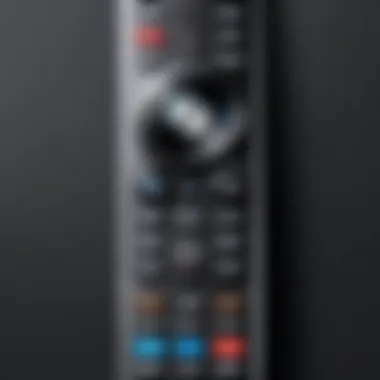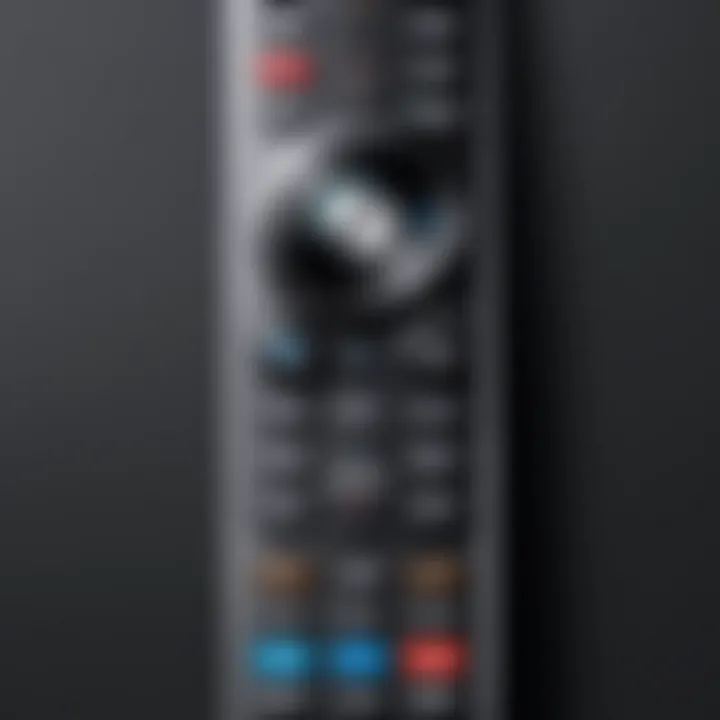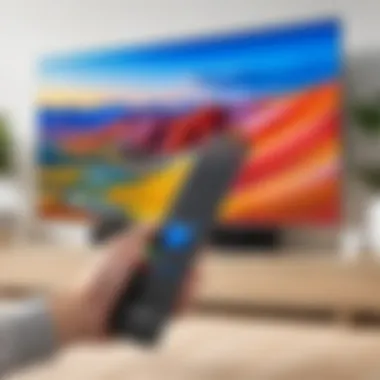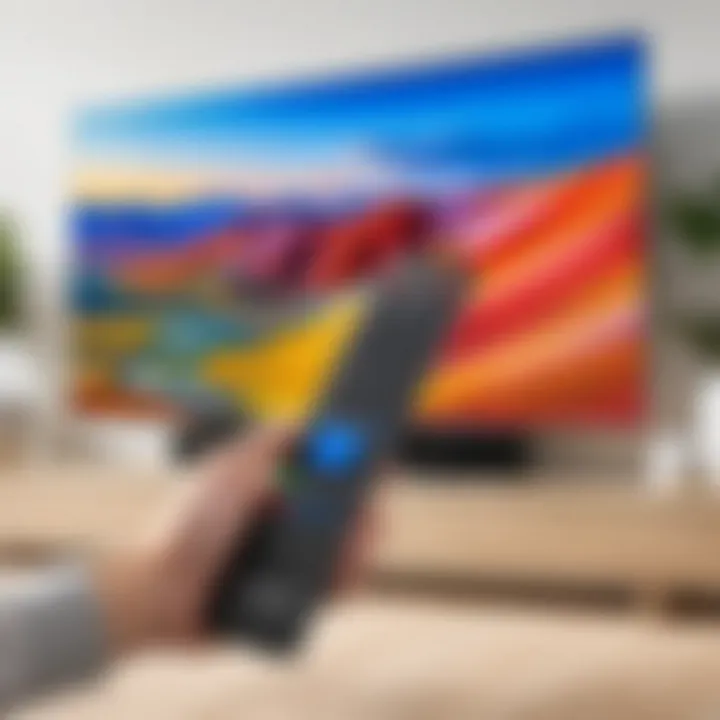Understanding Samsung TV Remote Infrared Technology


Intro
In today's world of rapidly advancing technology, understanding the mechanics behind everyday tools becomes essential, especially for those who want to maximize their experiences. One of these pivotal devices is the Samsung TV remote, which operates through infrared (IR) technology. This section sets the stage to delve into how IR technology works, its significance, and what makes it an integral part of the home viewing setup.
Infrared technology is like the unsung hero of remote control operation. While many might only think of pressing a button to change channels or adjust volume, there's a fascinating science at work behind that sleek device. The main focus of this article is to equip you, the savvy user, with insights about this technology, so you can get the most of your Samsung TV and its remote.
Let's embark on this journey of discovery to understand not only the functionality but also the distinctive attributes that Samsung brings to the table in IR technology.
Preface to Samsung TV Remote Infrared
With the advent of modern television, the humble remote control has evolved into an essential tool for enhancing our viewing experience. The introduction of Samsung TV remote infrared technology stands at the forefront of this evolution. Not only does it provide convenience, but it also embodies the progression of how we interact with our home entertainment systems.
Role of Remote Controls in Modern TVs
When it comes to the role of remote controls in modern TVs, they are not merely an accessory; they are integral to how we navigate our viewing preferences. Gone are the days of clambering up to the television to change a channel or adjust the volume. Instead, remotes allow viewers to recline comfortably, engaging with their preferred content at the touch of a button.
The versatility of remote controls is impressive. Beyond simple functions, many remotes now include features like voice recognition, smart home integration, and access to streaming services. This means the remote not only controls the television but rather acts almost as a command center for a myriad of devices. Consequently, using a Samsung TV remote with infrared capabilities can truly transform a simple entertainment setup into a sophisticated hub of activity.
Overview of Infrared Technology
Understanding infrared technology is pivotal to grasping how Samsung TV remotes operate. Infrared, a type of electromagnetic radiation, is used to transmit signals wirelessly over short distances. The technology relies on line-of-sight communication; this means that for infrared signals to be effective, there must be a clear path between the remote and the television.
In practical terms, when a button is pressed on the remote, it sends a coded signal in the form of pulses of infrared light. These pulses are then picked up by the TV sensor, which interprets them as commands. This method of communication is not only efficient but relatively inexpensive compared to other technologies.
"Understanding the foundations of infrared technology helps illuminate how our devices communicate. A simple push of a button sets off a chain reaction of signals, enabling us to control a world of content from our couches."
This overview sets the scene for a deeper exploration into the components and functions of Samsung remotes, as well as the advantages and disadvantages of such technology. As we delve into the details, a clearer picture of why infrared technology remains a staple in remote controls will emerge.
How Infrared Communication Works
Infrared communication plays a crucial role in the functionality of Samsung TV remote controls. Understanding how this technology operates can significantly enhance user experience, providing insight into its benefits and challenges. With technology advancing rapidly, knowing how infrared signals work becomes essential, especially for those who appreciate the nuances of their gadgets and seek to maximize their television viewing experience.
Basics of Infrared Waves
At its core, infrared communication relies on infrared (IR) waves, which fall beyond the visible spectrum on the electromagnetic spectrum. These waves are like invisible messengers. They are mainly categorized into near-infrared and far-infrared waves. The near-infrared variety is most commonly utilized in remote controls due to its strong directional properties.
- Invisible Nature: Since infrared waves are not visible to the naked eye, they cleverly transmit data without cluttering the living room with wires. This invisibility is a double-edged sword, as it makes them less susceptible to physical damage but also opens up challenges related to obstructions.
- Heat Generation: One interesting characteristic of infrared waves is that they generate warmth, which is why you might sometimes feel a slight heat from a remote when it's in use. This heat is simply the energy being transmitted, showcasing the fundamental principle at play.
To put it simply, infrared waves are akin to a whisper in a noisy room. They can travel effectively when unobstructed but may struggle to reach their destination if something stands in the way.
How Signals Are Transmitted
The transmission of signals through infrared technology involves a straightforward yet clever process. When you press a button on your Samsung TV remote, the remote control emits a signal through the infrared LED. This signal, a pulse of infrared light, conveys information in the form of binary code. This code consists of distinct long and short pulses.
- Encoding Information: The infrared light carries the on-and-off signals that the TV interprets as commands. For example, pressing the power button sends a specific code that instructs the TV to turn on or off. Each button on the remote has a unique code associated with it, making it a wonderfully simple yet effective form of communication.
- Distance and Directionality: While infrared communication allows for convenient control from a distance, it has its limitations. The range typically spans about 5 to 10 meters, depending on the device. Furthermore, because IR systems rely on line-of-sight, any obstructions like furniture or other electronic devices can interrupt the signal. It’s like trying to shout a message through a series of walls — it may not carry through effectively.
In summary, infrared signals are transmitted as coded pulses of light, enabling effective communication between your remote and your Samsung TV. Grasping these concepts provides essential context that enhances not just your technical roadmap but also your overall viewing experience.
Components of a Samsung TV Remote
When delving into the specifics of a Samsung TV remote, it’s crucial to grasp each component's role. Understanding these parts sheds light on how they work together to ensure smooth interaction between you and your television. Collectively, these components contribute to a seamless user experience, permitting effortless control over entertainment options.
Infrared LED Functionality
The infrared LED in a Samsung TV remote essentially acts as the heart of communication. It's responsible for sending out pulses of infrared light, which are invisible to the naked eye but can be detected by the TV's infrared sensor. When you press a button, the remote sends a specific pattern of infrared signals that correspond to a command—like changing the channel or adjusting the volume.
This technology allows for quick response times, since the signal travels at the speed of light. However, the LED's efficiency hinges on several factors: the angle from which you point it, the distance between the remote and the TV, and any obstacles in the path—like furniture or walls, which can absorb or reflect infrared signals.
Controls and Buttons Overview
A Samsung TV remote is often designed for maximum user-friendliness. The layout of buttons is typically intuitive, aimed at minimizing confusion.
- Key Functionality: Buttons for power, volume, channel changing, and menu navigation are usually easily accessible.
- Smart Features: Many remotes have dedicated buttons for streaming services like Netflix or YouTube, simplifying access to popular content.
- Shortcut Controls: Some remotes allow for programming specific buttons to customize your experience, making frequent tasks faster.
User feedback often highlights that the tactile response of buttons is crucial. People seek a satisfying click that assures them commands have been registered. If any buttons frequently fail to respond, it can lead to frustration. A good remote synthesizes design with technology to give you confidence in its performance.


Power Source Mechanism
Powering a Samsung TV remote typically involves the use of batteries. Most remotes utilize AA or AAA batteries, which are easy to replace and widely available. The design usually incorporates a battery compartment that is simple to access, allowing users to swap out old batteries for new ones without hassle.
Some modern remotes are venturing into rechargeable territory, but traditional batteries still hold dominance. The choice of battery affects how long the remote will function.
- Battery Life: Frequent users may require more powerful and long-lasting batteries to reduce the need for replacements.
- Low Battery Alerts: Some remotes signal users when power is dwindling, preventing unexpected interruptions during use.
In essence, a clear understanding of these components—the infrared LED’s functionality, button layout, and power mechanisms—enables users to appreciate the intricate technology that simplifies how they engage with their Samsung TV. The next sections will explore advantages and challenges of this technology, helping you to further understand its relevance in the modern entertainment landscape.
Advantages of Infrared Remotes
Infrared remotes have made their mark in the landscape of home entertainment, particularly with devices like Samsung TVs. Their appeal isn’t just based on nostalgia but rather on the practical merits they bring to the table. When it comes to controlling your television, infrared technology offers traits that can enhance the user experience. Let’s unpack some of the standout advantages of using infrared remotes, focusing on three specific areas: design and usability, cost-effectiveness, and reliability.
Simple Design and Usability
The first aspect that catches the eye is the simplicity of infrared remotes. Typically, the design features just a handful of buttons that allow you to navigate through channels and set options with ease. This straightforward interface often appeals to a broad audience, from tech enthusiasts to casual viewers. Users enjoy a quick learning curve; it’s usually intuitive enough that anyone can pick it up and start using it right away.
Moreover, the basic design of infrared remotes eliminates the distraction of unnecessary features. This enables you to focus on the actual functionality of the remote rather than figuring out complex menu systems or overly intricate setups. Just point and click—it's that simple! In a world that often overwhelms with technology, sometimes less truly is more.
Cost-effectiveness
Another notable perk is the cost-effectiveness of infrared remotes. Compared to other technologies, such as Bluetooth or Wi-Fi remotes, infrared remotes tend to be easier on the wallet. While there are smart remotes with advanced functionalities, infrared remotes provide reliable control without breaking the bank.
It's true that some people may initially think a more expensive remote is "better" due to additional features. However, for day-to-day operations and basic usage, an infrared remote suffices and gets the job done at a fraction of the cost. This makes it a practical choice for households seeking value without sacrificing quality. In this respect, investing in an infrared remote offers a worthwhile balance.
Reliability and Performance
When you talk reliability and performance, infrared remotes hold their ground well. They don’t rely on batteries that deplete quickly or require constant firmware updates. Instead, their operation is rather straightforward: send an infrared signal, and the TV responds accordingly. This reliability is crucial during those tense moments in a game or your favorite show when you need immediate control.
However, their performance shines brightest in environments with minimal interference. Since infrared technology is line-of-sight based, you'll notice it works seamlessly when there are no obstructions. Once you get accustomed to pointing directly at your Samsung TV, it becomes second nature.
"Infrared technology, in its essence, marries simplicity with performance, making it a go-to option for many TV users around the globe."
In sum, infrared remotes excel in several areas that truly matter. Their simple design and usability make them accessible, while their cost-effectiveness and reliability add significant value to the user experience. Choosing an infrared remote for your Samsung TV isn't merely about following the crowd; it's about recognizing its practical benefits that enhance your viewing enjoyment.
Challenges of Infrared Technology
Exploring the challenges of infrared technology is crucial for anyone looking to gain a thorough understanding of how Samsung TV remotes operate. This topic sheds light on the practical limitations that users may face while utilizing these remotes. Recognizing these challenges not only helps users devise workarounds but also informs their purchase decisions when considering new technology for home entertainment systems.
Line-of-Sight Requirement
One major hurdle in the use of infrared remotes is the need for a clear line of sight between the remote and the TV. This characteristic of infrared communication sets it apart from many other technologies such as Bluetooth, which don’t have this constraint. Without a direct path, signals may be blocked or absorbed by obstacles. For instance, if a person finds their remote doesn’t work well when there’s a coffee table in the way, or a picture frame blocking the IR sensor, it’s due to this very limitation.
Users should be mindful of their remote’s orientation and the surrounding environment. Moving furniture, for example, can help improve accessibility. If the TV is in a corner or tightly enclosed within a cabinet, this could result in an added frustration. Similar to how one needs to draw back curtains to let in sunlight, ensuring the remote has a clear path is vital for optimal performance.
"Good things come to those who wait, but that doesn’t apply to the relationship between remotes and their target devices."
Distance Limitations
Another factor contributing to the challenges of infrared technology is distance. Infrared signals typically have a range limitation, which can vary based on the specific model of the Samsung remote control. Generally, these remote controls function effectively within a range of around 30 feet, which might not be sufficient for large rooms or open spaces.
If users find themselves too far away from their TVs, the remote might not register inputs as promptly or might fail altogether. This limitation can become particularly evident if a person wants to control their television from a different room or while lounging too far away on the couch. It's like trying to shout across a wide canyon; the farther the distance, the less likely communication will be effective.
To navigate this, users might consider repositioning their seating arrangements or using signal boosters available on the market. Such adjustments can ensure that the remote continues to offer a seamless experience without compromising on comfort.
In summary, while infrared technology provides valuable advantages in control and functionality, users must acknowledge the potential hurdles. Understanding these limitations paves the way for smarter usage and enhances the overall user experience.
Troubleshooting Common Issues
In the realm of Samsung TV remote infrared technology, understanding common issues is essential for enhancing the overall viewing experience. Each component plays a significant role, and challenges encountered can hinder functionality. Addressing these intricacies ensures both user satisfaction and optimal performance. This section navigates through typical problems, focusing on not just what goes wrong, but how to rectify these hiccups for a seamless television interaction.
Remote Not Responding
Check Battery Levels
When your remote refuses to respond, the first step is often the simplest: check the battery levels. A dead or low battery is frequently the culprit behind this frustrating situation. This straightforward process doesn't demand technical expertise and serves as a cornerstone for troubleshooting overall remote functionality. Replacing batteries is often a quick fix that can dramatically enhance performance, restoring the harmony of your home entertainment experience.


One vital aspect of battery checks is the type of batteries used. Most Samsung remotes typically operate on either AA or AAA batteries. Misusing battery types or inserting them incorrectly can lead to power failures. Remember to examine if your new batteries are fresh as well. It may sound trivial, but even a factory-sealed pack can age poorly, compromising their efficacy.
Advantages/Disadvantages: The simplicity of checking battery levels makes this approach appealing, but relying solely on this step can be misleading if one overlooks other potential issues.
Inspect for Damage
If checking the batteries yields no results, the next avenue is to inspect the remote for physical damage. Inspecting for damage not only involves visible cracks or breaks; subtle issues, like misaligned buttons, can cease functionality. This step is crucial in diagnosing whether the problem lies within hardware, which is vital for operational integrity.
One key characteristic of this inspection is the user’s attention to detail, as even small nicks can affect performance. Visually examining the remote gives immediate insights into potential causes and paves the way for effective repairs. A thorough look may expose not just the obvious damage, but also reveal compromised internal components.
Advantages/Disadvantages: While this method can identify clear issues, it may miss internal problems not visible externally, requiring professional input or repairs in some cases.
Test Infrared Transmission
When options are running low, testing the infrared transmission may provide the needed clarity. Using a smartphone camera, the infrared LED can be observed while pressing any button on the remote. If a faint light shows on the phone display, it means the remote is transmitting signals, irrespective of other complications. This unique feature helps in determining if the infrared communication is, in fact, functioning correctly.
This method highlights the effectiveness of technology integration, utilizing everyday devices to troubleshoot. It’s an insightful approach that emphasizes interactivity and innovation in problem-solving. Recognizing whether the signal emits can save time, directing users towards alternative issues outside the remote itself.
Advantages/Disadvantages: Testing infrared transmission is pragmatic and easy, yet it may not account for obstructions that could disrupt the signal between the remote and TV.
Interference Issues
One significant aspect to consider in troubleshooting Samsung TV remotes revolves around interference issues, which can compromise the functionality of infrared communication. ◦ Identifying these obstructions is crucial for optimal usage. Understanding how a clear line of sight can influence signal strength opens doors to better remote control experiences.
Identifying Obstructions
Interference can often stem from physical barriers between the remote and the TV. Identifying obstructions—be it furniture, walls, or other appliances—can directly affect the correctness of signal transmission. Recognizing where the remote is used and in what environment lays the groundwork for resolving many common problems with remote controls.
One noteworthy aspect is the position of your TV and other equipment in relation to furniture. Even something like the angle at which a user sits can influence remote effectiveness. Adjusting the layout of your viewing area can sometimes lead to immediate improvement.
Advantages/Disadvantages: This method provides an easy-to-follow solution; however, on occasions where obstacles are unavoidable, you might consider alternative remote types that don't depend on line-of-sight.
Distance Considerations
Another key factor lies in distance considerations. Infrared has a limited range, with most remotes effectively working best within 15-30 feet of the device. While this is typically more than sufficient for most living rooms, the positioning of the TV impacts transmission reliability. Beyond a certain distance, even a nominal reduction in signal strength can lead to malfunctions.
This characteristic reinforces the importance of understanding the specifics of remote technology, allowing users to make adjustments that enhance overall experience. Regular communication and spatial awareness are crucial for success.
Advantages/Disadvantages: While noting distance is easy enough, it requires one to always be mindful of positioning, which might not always be practical depending on room layout.
Through these steps, troubleshooting common issues not only illuminates areas of concern but also equips users with knowledge on resolving them. Recognizing that each detail contributes collectively provides a more cohesive, informed approach to managing Samsung TV remote infrared technology.
Innovations in Remote Technology
The landscape of remote technology has undergone substantial transformation over the years, with Samsung at the forefront of these advancements. As televisions grow smarter, so too must the devices that control them. Innovations in remote technology are not merely about improving aesthetics or making devices look sleek. They ensure that users enjoy a more seamless and integrated viewing experience. With the rapid advancements in technology, especially in smart home ecosystems, the relevance of exploring these innovations has never been more critical.
Advancements in Smart Remote Controls
Smart remote controls have revolutionized how we interact with our televisions and other home devices. The cutting-edge models are equipped with features that facilitate control beyond basic television functions. These remotes can merge multiple device controls into one, reducing clutter and complexity. Instead of juggling a half-dozen remotes, users can manage everything through a single, intuitive interface.
For instance, many smart remote controls now come with voice recognition capabilities that allow you to issue commands simply by speaking. This hands-free technology has become increasingly favored among tech-savvy users, who appreciate the level of convenience it brings. Additionally, touch-sensitive controls enable a more dynamic interaction, feeling almost similar to using a tablet. With a user-friendly layout, these remotes provide shortcuts for frequently used functions, making navigation swift and intuitive.
Consider this: a user can quickly toggle between streaming platforms or adjust the picture settings without having to dive deep into menus. This efficiency not only enhances the viewing experience but also saves valuable time.
Integration with Smart Home Devices
As homes become smarter, the relevance of integrating remote controls with other smart devices grows significantly. Imagine using your Samsung TV remote not just to turn the TV on or off, but also to adjust your smart thermostat, dim the lights, or even lock your front door. This is no longer just a fancy idea; it is becoming a reality in many modern households.
Integration involves protocols like Zigbee or Z-Wave, allowing different devices to communicate seamlessly. For instance, smart remotes can sync with home assistants like Samsung SmartThings, letting you control all your compatible devices through a single interface. This unification streamlines home automation, offering a higher level of control and comfort.
"The future lies in homes that anticipate our needs, and remote technology is paving the way for this comfortable coexistence of devices."
This interconnectedness ensures that each device works in harmony, delivering a coherent experience tailored to individual preferences. Thus, as innovations in remote technology continue to unfold, embracing these changes not only elevates how we consume content but also transforms the very functioning of our homes.
The shift towards smart, integrated remotes highlights the ongoing evolution in remote technology, paving the path towards a truly automated living experience.


Comparative Analysis with Other Technologies
In today's tech-savvy world, home entertainment systems are getting smarter and more interconnected. The comparative analysis of different technologies that enhance user interaction, like remote controls, serves as a key aspect of understanding what truly ticks in electronics. Infrared technology has been a flagship feature in remote controls, like those used for Samsung TVs. However, other technologies, such as Bluetooth and Wi-Fi, offer various advantages and considerations that are worth dissecting.
Understanding how infrared compares to Bluetooth and Wi-Fi not only reveals its strengths but also highlights its limitations in practical use. Whether it's about control distance, interaction complexity, or the reliability of signals, knowing these can help consumers make better choices relevant to their viewing habits and homes.
Bluetooth vs. Infrared
Bluetooth has gained prominence in the realm of remote controls and device connectivity. While infrared remotes need line-of-sight to function properly, Bluetooth technology allows users to control devices without direct visibility. This multifunctionality makes Bluetooth quite appealing, especially in homes with various obstacles that could obstruct infrared signals.
On the flip side, Bluetooth generally features limited range compared to infrared. For instance, typical infrared remotes can usually operate up to around 30 feet without interruption in line-of-sight, whereas Bluetooth may falter over long distances in larger environments. Additionally, connecting Bluetooth devices often requires pairing, which may present a complexity not found in simpler infrared setups.
Key Differences:
- Range: Infrared presents a longer operational distance under optimal conditions.
- Line of Sight: Bluetooth doesn’t require uninterrupted pathways.
- Ease of Use: Infrared remotes often plug-and-play, while Bluetooth requires pairing processes.
Wi-Fi Remote Controls
Wi-Fi remote controls have become increasingly common, especially in smart home ecosystems, offering a wealth of features that infrared and Bluetooth can’t touch. With Wi-Fi, many devices can be controlled through applications on smartphones or tablets, allowing for much greater flexibility.
One of the key advantages of Wi-Fi connectivity is the substantial information bandwidth it possesses. This makes it possible for users to not only control their TV but also manage a host of connected devices like lights, thermostats, and cameras—all from a single interface. Additionally, the range is notably broader than both infrared and Bluetooth; as long as you’re on the same Wi-Fi network, device functionality won’t be hindered by physical barriers.
Despite the benefits, Wi-Fi remotes often require more complex setups and could face issues related to network disruptions. Unlike infrared remotes, which function solely on direct signals, Wi-Fi relies heavily on network conditions.
In summary, when comparing infrared to both Bluetooth and Wi-Fi technologies, there’s no absolute winner—rather, the choice hinges on the user's specific needs and preferences in their home entertainment setup. To make an informed decision, consider how each technology aligns with your lifestyle and the environment in which your devices operate.
User Experience and Practical Tips
User experience is a pivotal element when discussing Samsung TV remote infrared technology as it not only governs how effectively one can navigate their television but also impacts the overall viewing experience. A solid grasp of practical tips enhances the convenience and efficiency of using the remote, making everyday operations seamless.
A well-functioning remote control can act like a magic wand. With it, viewers have instant access to a plethora of content, changing channels or adjusting volume without a hitch. However, to make the most of this device, understanding its functionality is essential.
Maximizing Remote Functionality
To fully utilize your Samsung TV remote, a few strategies can make a significant difference. First, familiarize yourself with the layout of the buttons. Knowing which button does what avoids fumbling around or accidentally disrupting your binge-watching session. Additionally, the remote can often do more than just channel surf. Many remotes feature dedicated buttons for popular streaming services like Netflix or Amazon Prime Video, allowing you to dive straight into your favorite shows without unnecessary delays.
A key component to maximizing this gadget is ensuring it has fresh batteries. Nothing's more frustrating than a remote that won’t respond, particularly during that dramatic cliffhanger. If your remote is acting sluggish, replace those batteries. Furthermore, if the remote can connect to your TV via Bluetooth or Wi-Fi, ensure it is on the same network to enhance responsiveness.
Consider also the positioning of your TV and remote when using it; infrared signals work best with a clear line of sight. If your setup looks more like a maze than a simple TV stand, you might encounter hiccups in operation.
"A well-positioned remote can change the way you experience TV – take care of the little things for a big difference."
Tips to consider:
- Keep your remote in a consistent location.
- Regularly clean the remote to prevent dirt and grime buildup.
- If frequently using smart features, consider remapping buttons to suit your preferences.
Maintaining Your Remote Control
Maintenance of your remote control is crucial for ensuring a smooth operation over time. The first step is to regularly clean the device. Dust and dirt can gather between the buttons, impeding functionality. A soft cloth dampened with a little water (or isopropyl alcohol) works wonders for the removal of smudges and debris. Always remember to unplug your TV before starting any cleaning process.
Next, consider the power supply. A remote that suddenly conks out may just need simple battery replacement. It is also wise to check for battery corrosion; if you find any, clean the compartment carefully to avoid any short circuit or further damage.
For those adventurous types, consider researching different battery brands. Some might last longer than others, giving consumer insight into longevity and performance. Investigating user reviews on platforms like Reddit can provide real-world feedback on battery life and performance.
Lastly, safeguarding your remote from accidental drops will lengthen its life. Keeping it away from edges and utilizing protective covers can save it from unfortunate mishaps.
By taking the time to maximize functionality and maintain your remote control, you can significantly enhance your user experience, making every moment spent watching your favorite shows more enjoyable.
Finale
In the realm of modern television technology, the conclusion of our exploration into Samsung TV remote infrared technology encapsulates crucial elements that shape user experience and system functionality. As discussed throughout this article, the robust yet straightforward nature of infrared technology is significant for several reasons. It addresses the primary interaction interface between the user and the television, influencing the overall satisfaction with viewing experiences. Understanding this technology illuminates the pathway forward for consumers, equipping them with knowledge for any future transitions or upgrades.
Future of Remote Technology
The future of remote technology is both exciting and challenging. With the rapid pace of innovation in tech, possibilities are expanding beyond what we can currently fathom. As we look ahead, it's pivotal to consider how traditional infrared remotes might evolve or coexist with emerging technologies. Smart remotes, capable of interfacing with various home devices, present a fascinating shift in how we perceive remote control functionalities.
- Enhanced Integration: Imagine a single remote that not only controls your TV but also your lights, thermostat, and other smart devices seamlessly. This speaks volumes of convenience for users.
- Voice Command Capabilities: With voice recognition technology maturing, there’s a trend to incorporate voice commands in remote devices. Users may find themselves engaging with their media in more intuitive and hands-free ways.
- User-Centric Design: Future remotes could see a push towards user-centered designs, possibly allowing customization of button layouts and functionalities based on individual preferences.
Moreover, the advancement of connectivity technologies such as Bluetooth and Wi-Fi could diminish the line-of-sight limitation placed upon infrared remotes. This may provide users with greater flexibility in device placement and control spans. In a nutshell, the trajectory of remote technology is likely to lean toward creating more interactive and integrated user experiences, promoting ease of use and efficiency in managing modern entertainment ecosystems.
"The future is not something we enter. The future is something we create." — Leonard I. Sweet
As technology matures, so too does the expectation that remote controls will keep pace, evolving to meet the needs of increasingly complex smart home environments. Keeping an eye on these trends can empower users to make informed decisions when it comes to upgrading their home systems.







